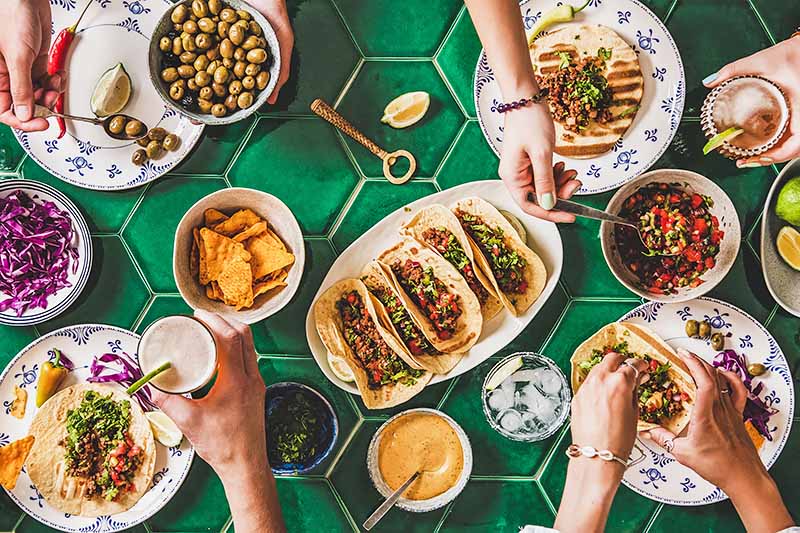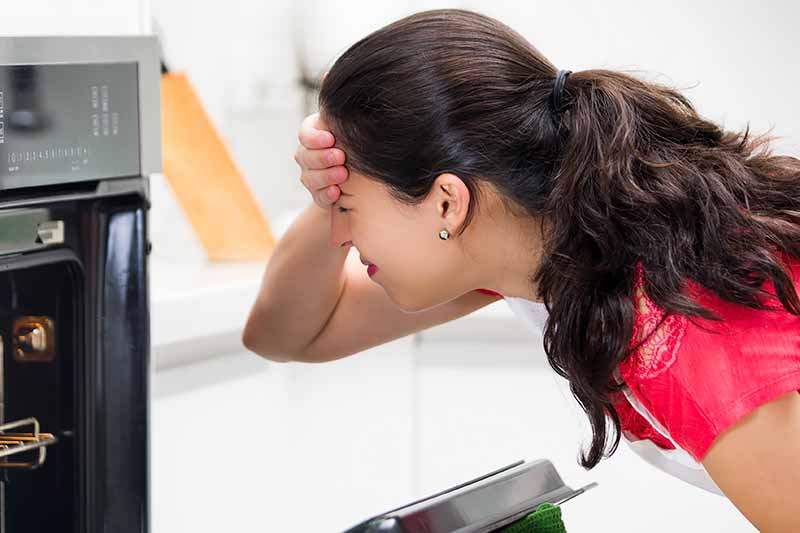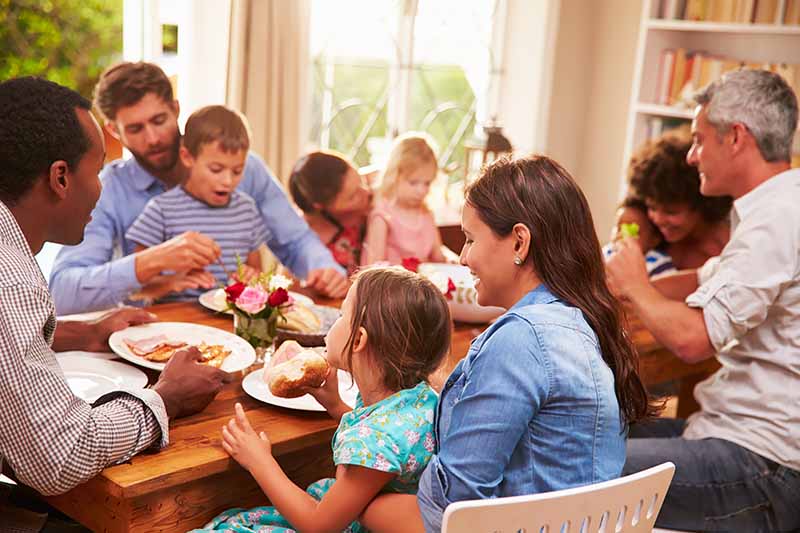Whether you’re an avid meal prepper already, or you’re simply puzzling over how exactly to serve the group of fifteen friends and family members that are coming over to enjoy a meal, we can help.

Planning out your meals and cooking once a week so all of the dishes and ingredients you’ll need are ready to enjoy throughout the days ahead is one thing, but pulling out the extra chairs from the garage and trying to figure out how to feed everyone that’s on their way can be a difficult task.
Do you have a large crowd coming over for dinner? Here are a few tips for cooking large batches to feed them all.
First, a quick rundown of what’s ahead:
Tips for Cooking in Bulk for Large Dinner Parties
Let’s get to it!
1. Stick with Recipes That You Know Will Double or Triple Well
Unless you thrive under pressure, it’s best to stick with recipes that you already know will work.

Maybe you have a favorite lasagna or enchilada recipe, a stellar game day chili, or a well-worn index card that holds the secrets to making your grandma’s favorite casserole – in a quantity that’s only worthy of serving on special occasions, because it makes far too much in one go for the members of your household to consume quickly. Now’s the time for those!
Whereas baked goods that rely on careful measuring to create specific proportions of ingredients to ensure that perfect rise or texture cannot typically be doubled easily without throwing things out of whack, simple casseroles, stews, soups, and other savory menu staples can be multiplied to meet your needs, without needing to make too many adjustments to get the final flavor and texture just right.
2. Consider Make-Ahead Dishes
To take some of the pressure off of yourself, and so you’ll have time to actually enjoy the event that you’re planning, try to pick a recipe or two that you can make ahead of time the night before, or that can be prepared in a slow cooker.

A large batch of meatballs in red sauce simmering away on the counter in the Crock-Pot alongside a selection of various cheeses and rolls for serving is a perfect setup for a party meal, and making a big batch of those meatballs in advance will give you time to enjoy a glass of wine, and chat with your relatives.
To make sure you get the timing just right, allow plenty of time for soups or casseroles that have been made in advance and frozen to defrost in the fridge before party time, ensuring that they’ll heat through when you pop the pot on the stove or your pan in the oven to reheat.
3. Determine How Much Food You Need
Depending on how much your guests like to eat, a good rule of thumb is to provide half a pound of poultry or beef, four to five ounces of pasta or one and a half ounces of grains, and three to four ounces of veggies per person.

Whether these are served in combination in a big batch of pasta with meat sauce and salad in the side, or you’re making a separate protein and sides in bulk, a la a big roast beef with roasted broccoli and mashed potatoes, do the math before you shop, and plan accordingly.
4. Make a Game Plan
A few days before your event, take a look at your recipes to determine the order in which you need to prepare and cook them, as well as ingredients that can be prepped or items that can be cooked in advance. Make yourself a list, and stick to it.

Confirm that you have all of the necessary ingredients on hand, including anything you’ll need for garnishes or serving.
I also like to try to give myself a bit of extra time on the day of the event, in case of inevitable distractions. It’s nice when friends congregate in the kitchen, but all of that chatting can result in a time out in the cooking department!
5. Don’t Overstuff Your Oven
The more you put in your oven, the longer everything will take to cook.

If you are going to be making two batches of a casserole, just keep in mind that the total cooking time required may be longer than it would typically be if you were baking just one. And a big batch of soup or chili is going to take longer to reheat than the single bowlful that you would heat up in the microwave for yourself for lunch.
Understanding your oven is a good knowledge set to have for batch cooking as well. If you know in advance whether your appliance actually hits the temperature that you set it to or not, and where the hot spots are, you can plan accordingly.
6. Spices and Herbs Shouldn’t Always Be Doubled or Tripled
As I mentioned earlier, just because some recipes or ingredients can be doubled with good results doesn’t mean they all can.

Since it’s easy to accidentally overseason, start by adding just one and a quarter times the amount of a spice or seasoning called for when doubling a recipe, and then add more to taste.
If you’ve oversalted or your meal’s a tad too spicy, the quick fixes outlined in these articles can help.
7. Don’t Use Too Much Fat
Oil is another ingredient that may not need to be doubled if you’re making a recipe in bulk.

For ingredients that are cooked in a frying pan, use just enough oil to coat the pan, and no more. This may or may not actually turn out to be double the amount called for in the original recipe.
8. Use Pans That Are the Proper Size
Food needs room to cook, so make sure you aren’t cramming your ingredients into pots and pans that are too small.

Doubling a recipe may mean it’s best to utilize those extra burners and put two or three pans on the stove to brown the mushrooms, sweat the onions, or sear the meat.
Don’t have the extra space, or the necessary cookware? Not a problem!
As long as you have appropriately sized serving vessels, you can prepare ingredients for many recipes in batches as needed, working with smaller quantities at a time that fit into the pots and pans you have, and setting them aside before combining and completing the dish.
9. Make Leftovers Count
It’s always better to have a bit more food than you’ll need for a big party, but this can often result in leftovers.

If you’re not aiming to fill up the fridge, buy a package of disposable containers in advance, so you can send guests who enjoyed the meal home with a little extra. Or come up with creative ways to repurpose the leftovers for lunches and dinners at home the following week.
Remember, however, that food safety is important. A general rule of thumb to follow is that no foods should be left out at room temperature for more than four hours. Hot foods should be kept hot, and cold foods should stay cold.
If anything sat for a bit too long, or you’re not sure if there may have been temperature issues, toss it out.
Enjoy the Eats
Once your menu is planned, and after the cooking is complete, you can sit back, relax, and enjoy the company of your guests.

Remember that cooking a big single dish like a casserole with a simple salad on the side can help to free up time that you would have otherwise spent in the kitchen preparing twelve different side dishes. And something like a chili or taco bar allows friends and relatives to customize their own plates to their liking, with minimal cook time required to prepare enough food to make everyone happy.
Keep the size of your cookware in mind, and try to avoid overseasoning or using too much fat when you double or triple your recipes. Your dinner party is sure to be a huge success!
What’s your go-to recipe for serving a crowd? Let us know in the comments section below! And feel free to reach out if you have any questions that we can help with as well.
Looking for even more ways to improve your skills in the kitchen? Read these how-to guides from Foodal next:
- How to Cook Chili in an Electric Pressure Cooker
- How to Cook in Bulk: Save Time and Money with These Meal Prep Tips
- How to Make the Perfect Fried Egg
© Ask the Experts, LLC. ALL RIGHTS RESERVED. See our TOS for more details. Photos via Shutterstock. With additional writing and editing by Allison Sidhu.
About Kelli McGrane, MS, RD
Kelli McGrane is a Denver-based registered dietitian with a lifelong love of food. She holds undergraduate and master’s degrees in nutrition science from Boston University. As a registered dietitian, she believes in the importance of food to nourish not only your body, but your soul as well. Nutrition is very personal, and you won’t find any food rules here, other than to simply enjoy what you eat.




